Control block
1. Remove the panel at the bottom "torpedoes".
2. Release the 4 retaining clips and remove the cover from the heater core casing.
4. Note the position of the heater control rods in their clamps. If necessary, mark the rods and then disconnect them from the heater housing and from the damper release levers in the air distributor housing (see fig. 2.10).
5. Unscrew the 2 self-tapping screws securing the heater control unit and remove it (see Fig.2.11).
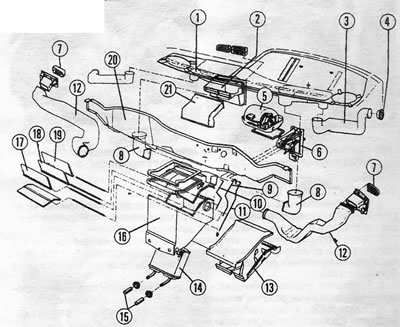
Pic. 2.5. Heating system design: 1. Panel gaskets "torpedoes"; 2. Fresh air channel; 3. Side air nozzle channels (removing fog from window glass); 4. Side air nozzles (removing fog from window glass); 5. Blower motor; 6. Control unit; 7. Side heater vents; 8. Hose for defogging the windshield; 9. Control rod (air distribution valve); 10. Control rod (air mixing system); 11. Control rod (top control valve); 12. Heater ventilation hose; 13. Heater core casing; 14. Heater core; 15. Supply and return hoses of the cooling system; 16. Air distributor housing; 17. Upper air distribution valve; 18. Air mixing system damper; 19. Lower air distribution valve; 20. Engine compartment partition; 21. Central air duct.
6. Install the control unit in the reverse order. The control rods must be connected in the following sequence:
- A. Short pull - to the upper air distribution valve lever
- b. Intermediate rod - to the lever of the upper air distribution valve
- V. Long rod - to the damper of the air mixing system.
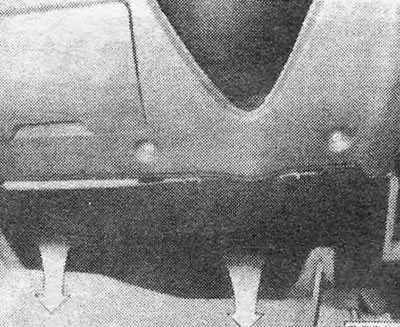
Pic. 2.6. Removing the panel "torpedoes" to gain access to the heater control unit
Blower motor
7. Open and support the hood lid.
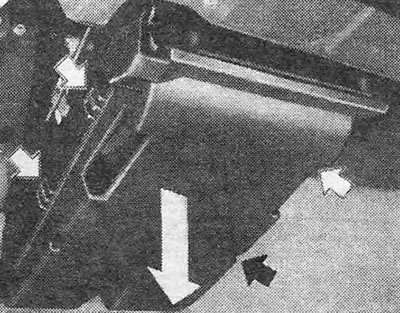
Pic. 2.7. Removing the bottom cover of the heater core - the cover's fixing clips are shown by arrows
8. Remove the water deflector (if available) from the hole in the upper part of the engine compartment partition (see Fig.2.12).
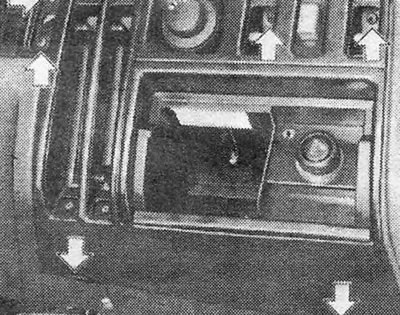
Pic. 2.8. Removing the Switch Panel (clamps and screws are shown by arrows) - left-hand drive model
9. Disconnect the blower motor multi-pin plug (see photo).
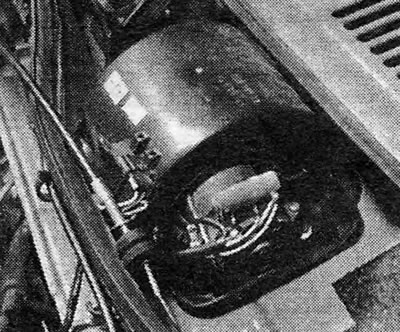
Photo 15.9. Heater blower motor.
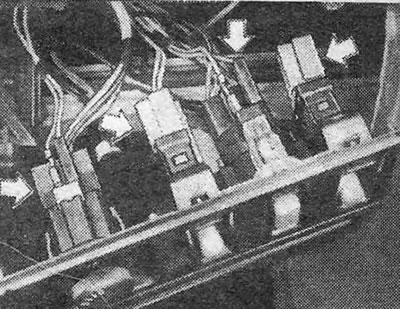
Pic. 2.9. Electrical switch plugs (shown by arrows)
10. Release the clamps securing the cover over the engine and remove it.
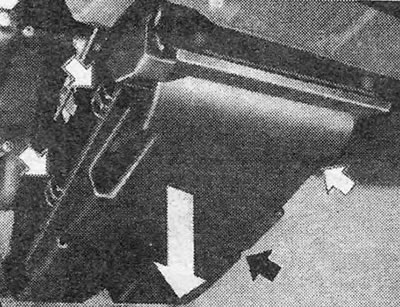
Pic. 2.10. Control rods and levers (shown by arrows)
11. Remove the 2 screws securing the engine and remove it.
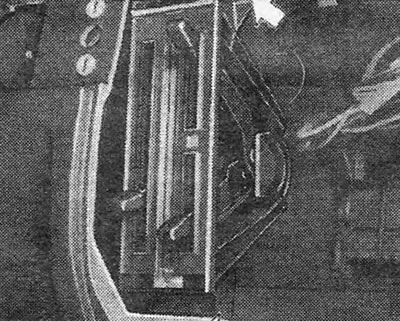
Pic. 2.11. Screws securing the heater control unit (shown by arrows)
12. Install the engine in the reverse order.
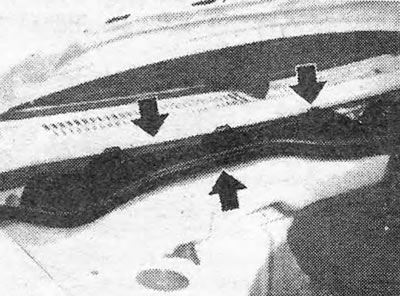
Pic. 2.12. Removing the water deflector (mounting clips and screws are indicated by arrows)
Heater core
13. Clamp the heater hoses at the rear partition of the engine compartment.
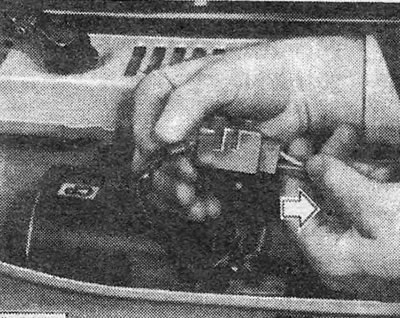
Pic. 2.12. Removing the water deflector (mounting clips and screws are indicated by arrows)
14. Disconnect the hoses from the heater core pipes.
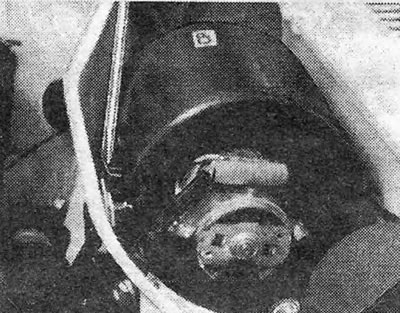
Pic. 2.14. Removing the clips holding the cover over the blower motor
15. Plug open pipes to prevent coolant from spilling while removing the core.
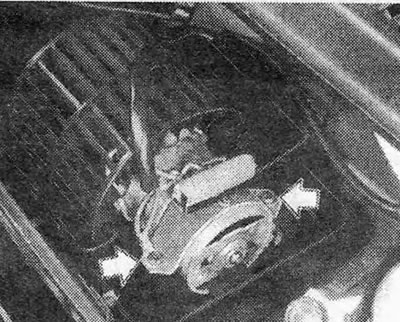
Pic. 2.15. Blower Motor Mounting Screws (shown by arrows)
16. Remove 2 screws and remove the center console.
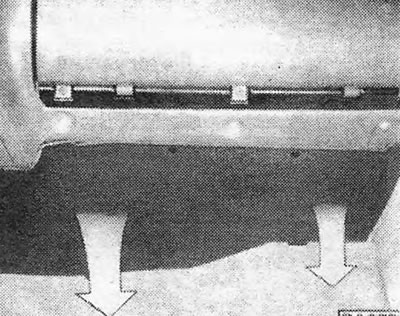
Pic. 2.16. Removing the lower right panel "torpedoes" (shown by arrows)
17. Remove the lower left and then the lower right panel "torpedoes" (see chapter 11).
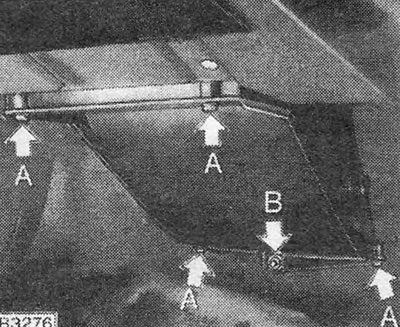
Pic. 2.17. Attaching the heater core casing to the air distribution chamber
18. Release the 4 clamps and remove the cover at the base of the heater core casing (see photo).
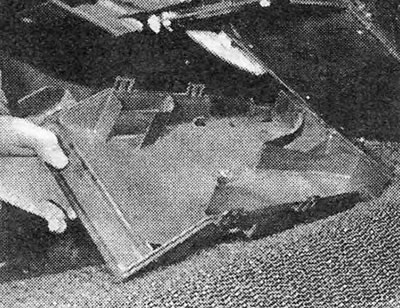
Photo 15.18. Heater Blower Motor Cover.
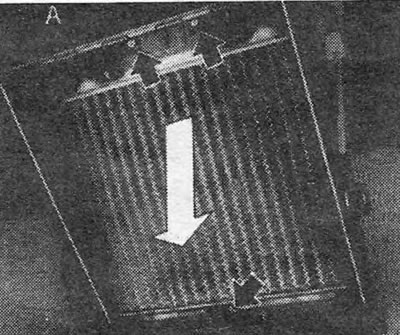
Pic. 2.18. Core mounting screws visible when flap (A), standing upright
19. Remove the 4 screws and 1 nut that hold the air plenum flanges together (see fig. 2.17).
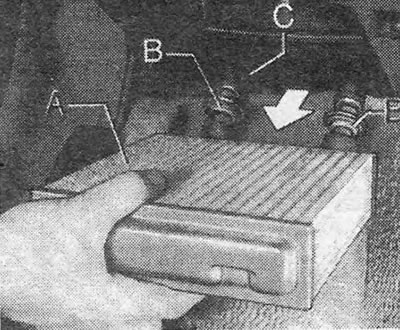
Pic. 2.19. Removing the heater core: A. Core; B. Rubber bushing; C. Septum.
20. Disconnect the control rod of the air mixing system flap.
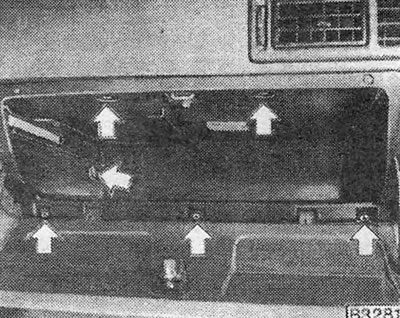
Pic. 2.20. Screws securing "boardwalk" (shown by arrows)
21. Disconnect the rod on the right side.
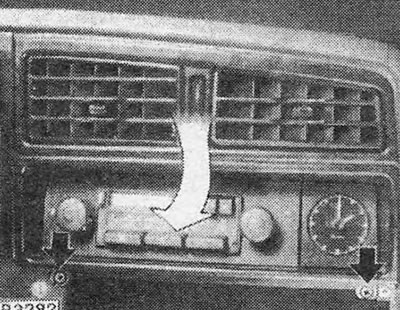
Pic. 2.21. Removing the Center Fresh Air Vent Housing (mounting screws are shown by arrows)
22. Unscrew the screws securing the core and pull it out of the heater casing. To reach the top screws, move the flap (A) to a vertical position (see fig. 2.18). As the core is removed, pull the pipes and their sealing sleeves through the partition (be prepared for some coolant spillage).
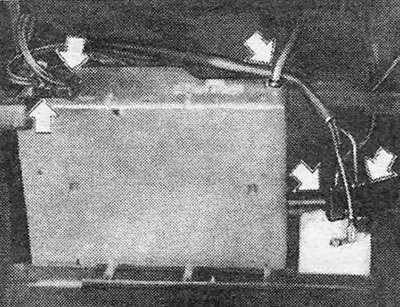
Pic. 2.22. Electrical plugs for radio and clock (shown by arrows)
23. If the core is clogged, you should try backwashing (as for a radiator - see section 4). If that doesn't help, try adding radiator cleaner to the water (used strictly in accordance with the manufacturer's instructions).
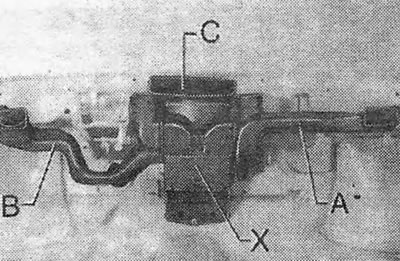
Pic. 2.23. Air distributor housing with ventilation ducts: A. Heater side vent channel; B. Heater side vent duct; C. Center vent (for windshield); X. Air distributor housing.
24. If the core leaks, you should have it repaired by a specialist or replace it with a new one. Do not attempt to repair it yourself.
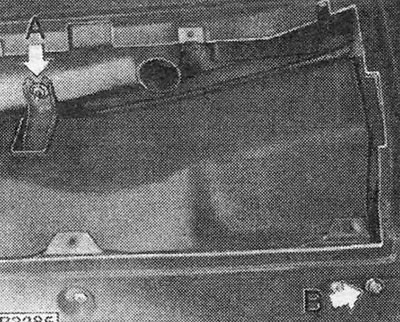
Pic. 2.24. Screws (A) And (IN), fastening the dashboard
25. Install the core in the reverse order.
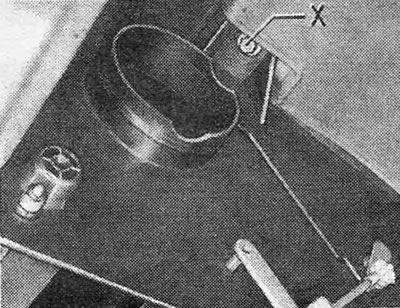
Pic. 2.25. One of the screws (X), securing the air distributor housing to the partition
26. Fill the system with coolant. On 1.3 engines, bleed the cooling system (see section 6).
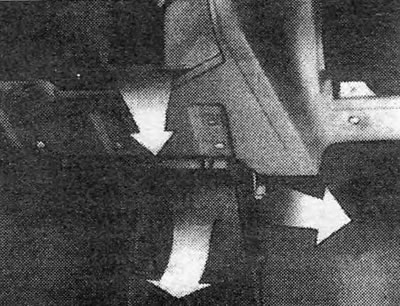
Pic. 2.26. Removing the air distributor housing
Air distributor housing
27. Remove the heater core (see paragraphs 13-22).
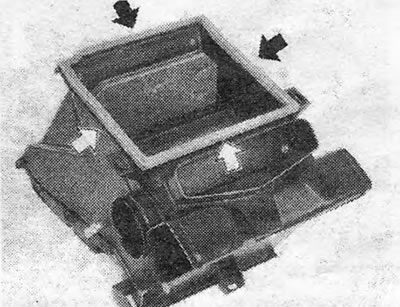
Pic. 2.27. Air distributor housing flange sealing strip (shown by arrows)
28. Unscrew the screws and remove "boardwalk" (see fig. 2.20).
29. Remove the screws securing the switch panel. Pull the panel out, disconnect the plugs from the switches and remove the panel.
30. Remove the 2 mounting screws and remove the heater lever assembly.
31. Remove the 2 screws securing the center fresh air vent housing, pull the housing down and out, and remove it from "torpedoes".
32. Disconnect the wiring from the radio and clock (if any) (see fig. 2.22).
33. Disconnect from the air distributor housing (X) Heater side vent ducts and hose (see fig. 2.23).
35. Disconnect the air distributor housing at the top from the partition and at the bottom from the panel "torpedoes" (see fig. 2.25).
36. Remove the air distributor housing (see fig. 2.26).
37. Installation of the air distributor housing is carried out in the reverse order. Check the condition of the foam sealing strip (see Fig.2.27) and connect the control rods (see paragraph 6).

Visitor comments